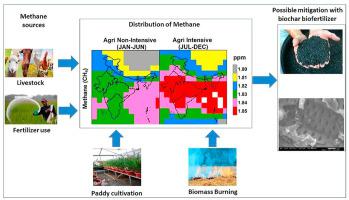Journal of Environmental Management ( IF 8.0 ) Pub Date : 2021-04-10 , DOI: 10.1016/j.jenvman.2021.112526 A. Singh , J. Kuttippurath , K. Abbhishek , N. Mallick , S. Raj , G. Chander , S. Dixit

|
Methane (CH4) is a prominent Greenhouse Gas (GHG) and its global atmospheric concentration has increased significantly since the year 2007. Anthropogenic CH4 emissions are projected to be 9390 million metric tonnes by 2020. Here, we present the long–term changes in atmospheric methane over India and suggest possible alternatives to reduce soil emissions from paddy fields. The increase in atmospheric CH4 concentrations from 2009 to 2020 in India is significant, about 0.0765 ppm/decade. The Indo-Gangetic Plains, Peninsular India and Central India show about 0.075, 0.076 and 0.074 ppm/decade, respectively, in 2009–2020. Seasonal variations in CH4 emissions depend mostly on agricultural activities and meteorology, and contribution during the agricultural intensive period of Kharif–Rabi (i.e., June–December) is substantial in this regard. The primary reason for agricultural soil emissions is the application of chemical fertilizers to improve crop yield. However, for rice farming, soil amendments involving stable forms of carbon can reduce GHG emissions and improve soil carbon status. High crop production in pot culture experiment resulted in lower potential yield–scaled GHG emissions in rice with biochar supplement. The human impact of global warming induced by agricultural activities could be reduced by using biochar as a natural solution.
中文翻译:

与印度最近大气中甲烷增加的生物联系
甲烷(CH 4)是著名的温室气体(GHG),自2007年以来,其全球大气浓度显着增加。到2020年,人为产生的CH 4排放量预计为93.9亿公吨。在这里,我们提出了长期变化在印度的大气甲烷中进行研究,并提出了减少稻田土壤排放的可能替代方法。从2009年到2020年,印度大气中的CH 4浓度显着增加,约为每十年0.0765 ppm。2009-2020年,印度恒河平原,印度半岛和印度中部分别显示约0.075、0.076和0.074 ppm /十年。CH 4的季节性变化排放量主要取决于农业活动和气象,在哈里夫拉比农业密集期(即6月至12月),这方面的贡献很大。农业土壤排放的主要原因是使用化肥来提高农作物的产量。但是,对于水稻种植而言,涉及稳定碳形态的土壤改良剂可以减少温室气体排放并改善土壤碳状况。盆栽试验中作物的高产量导致含生物炭补充剂的水稻潜在的量级GHG排放量降低。通过使用生物炭作为天然溶液,可以减少农业活动引起的全球变暖对人类的影响。










































 京公网安备 11010802027423号
京公网安备 11010802027423号